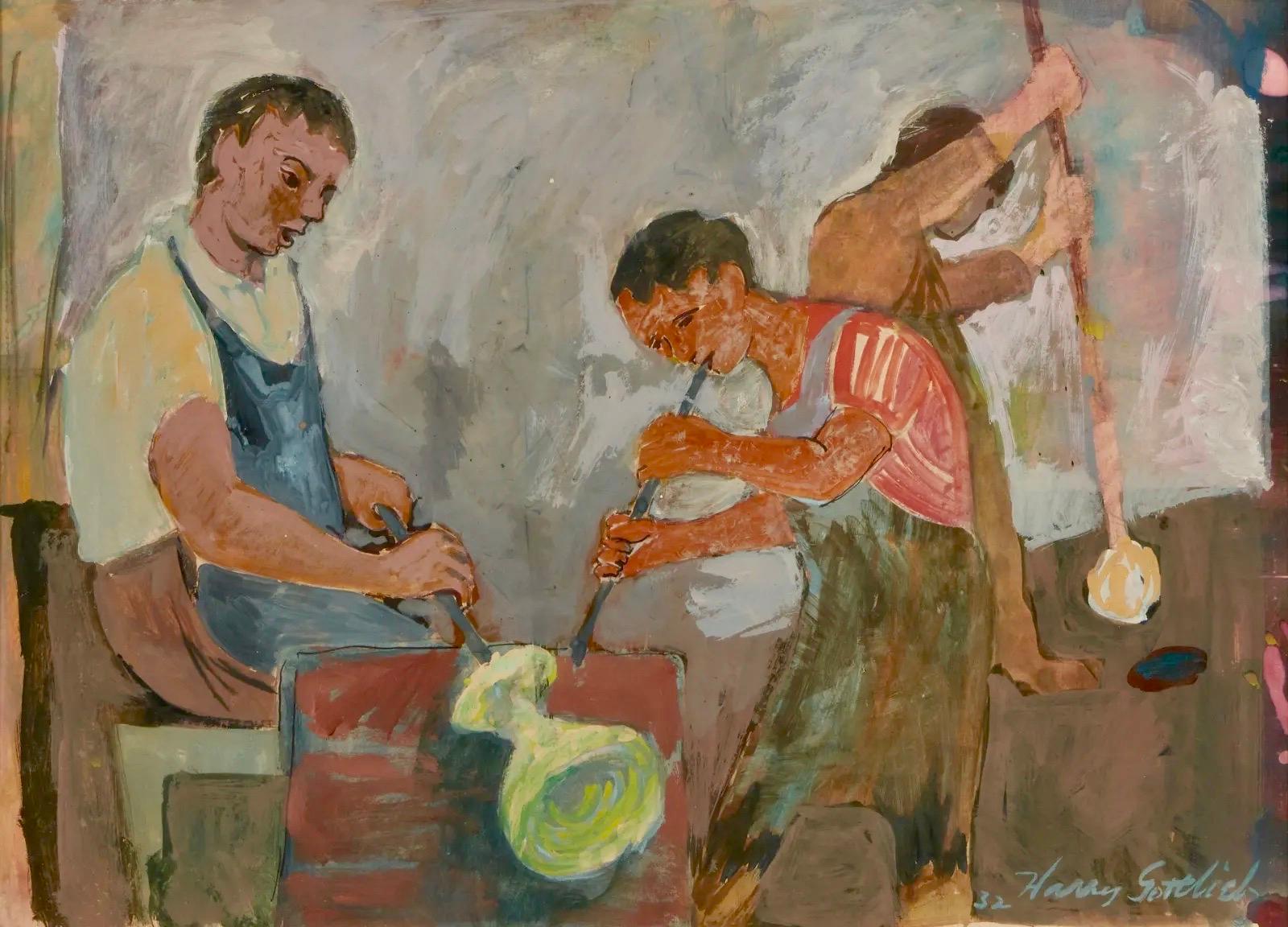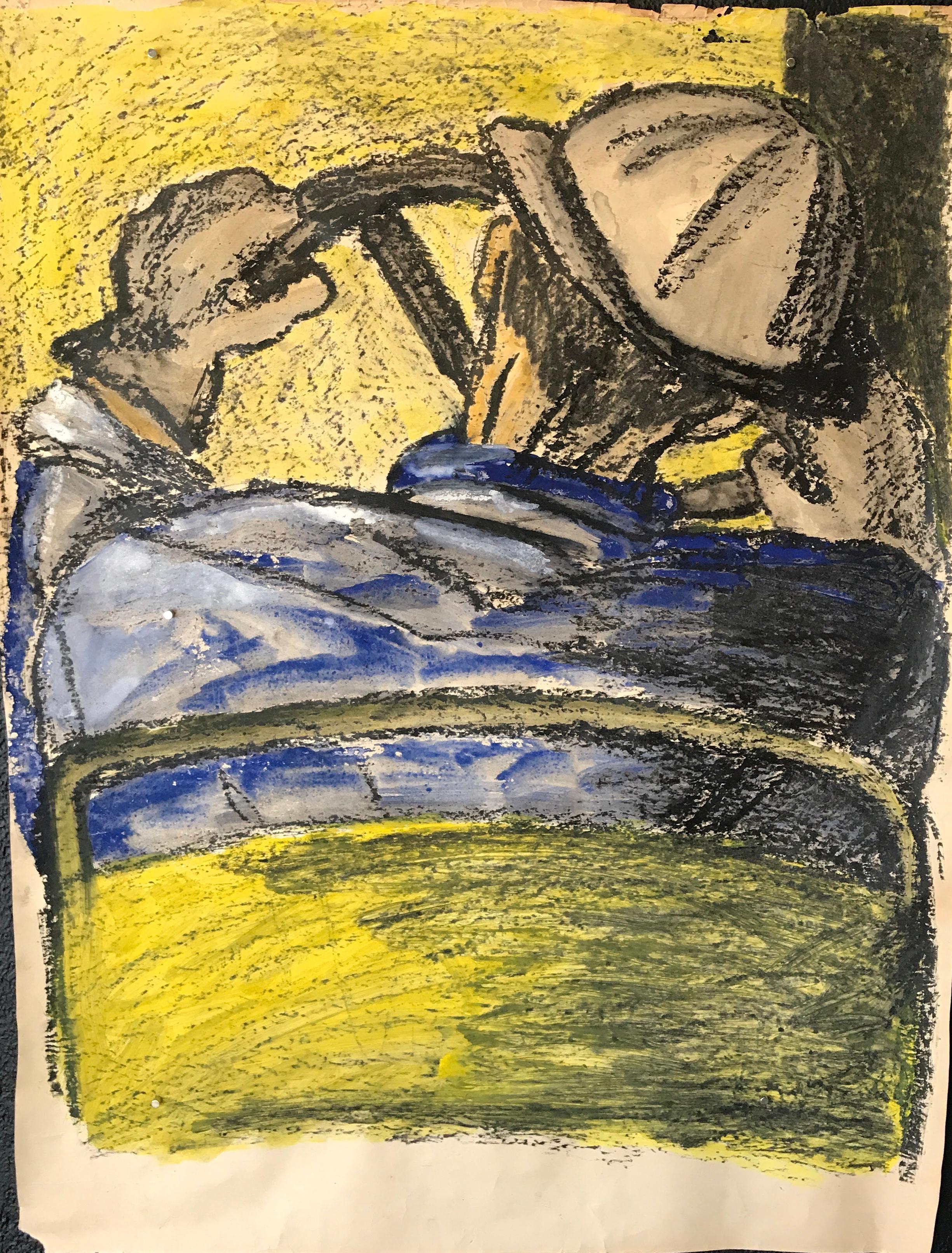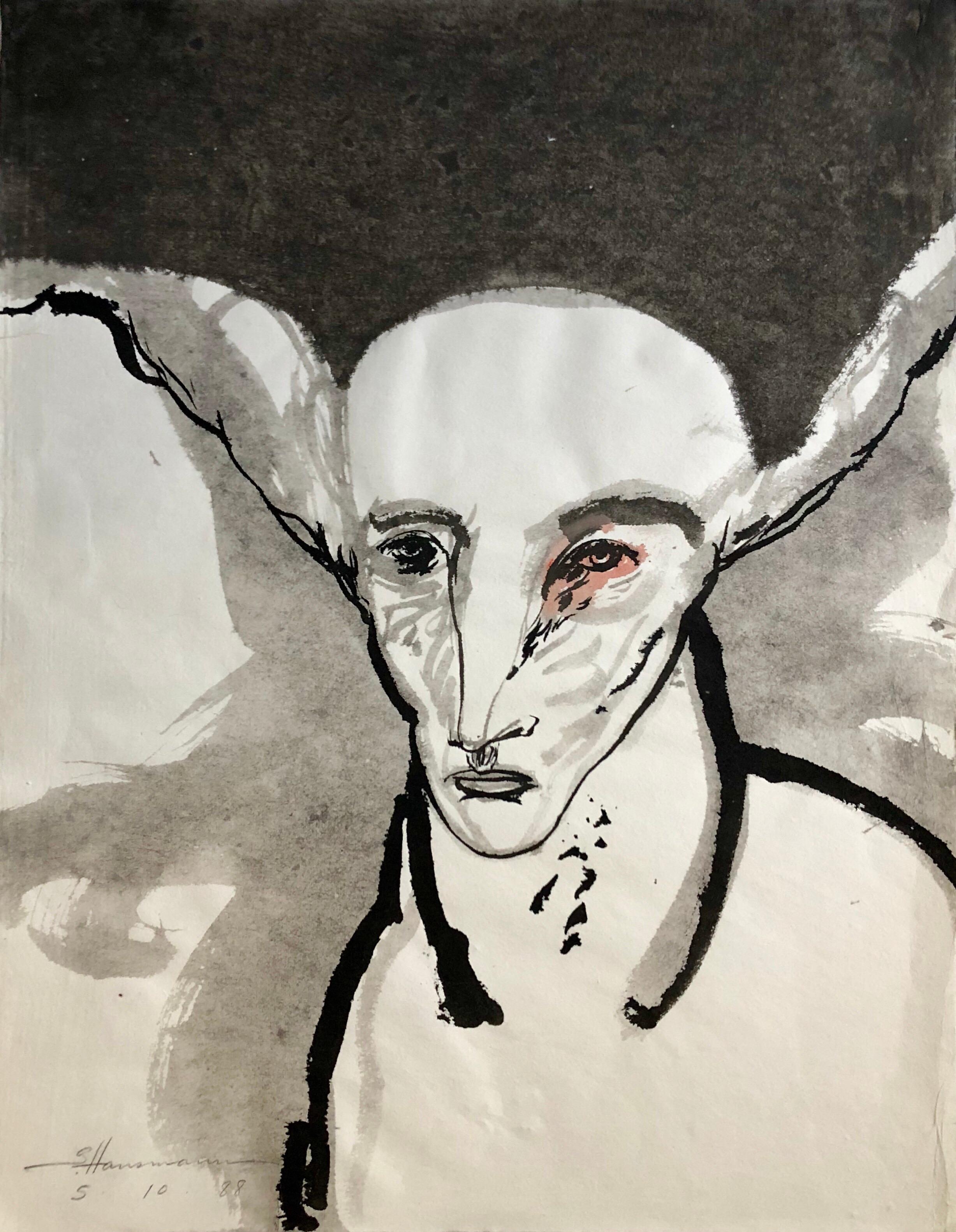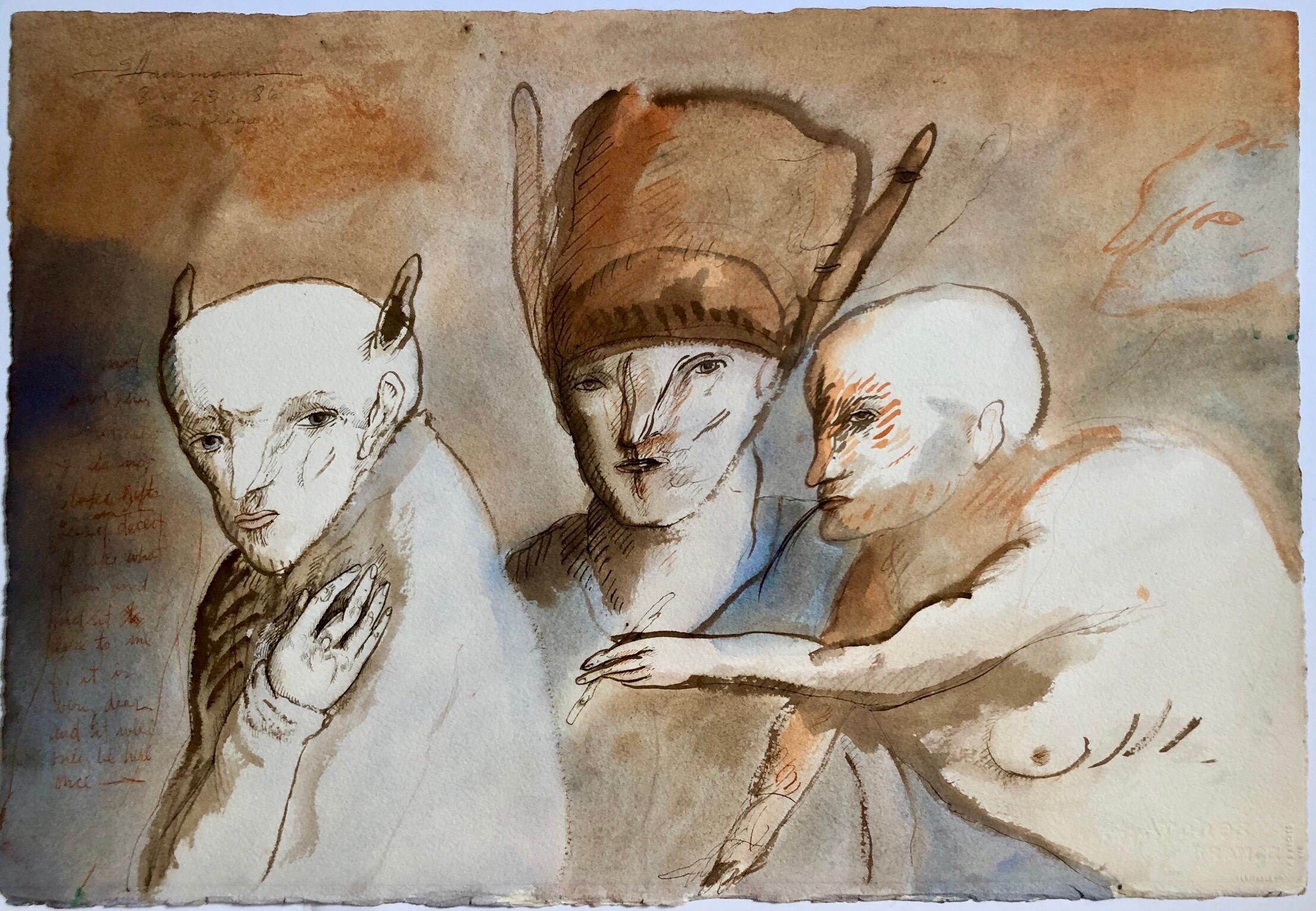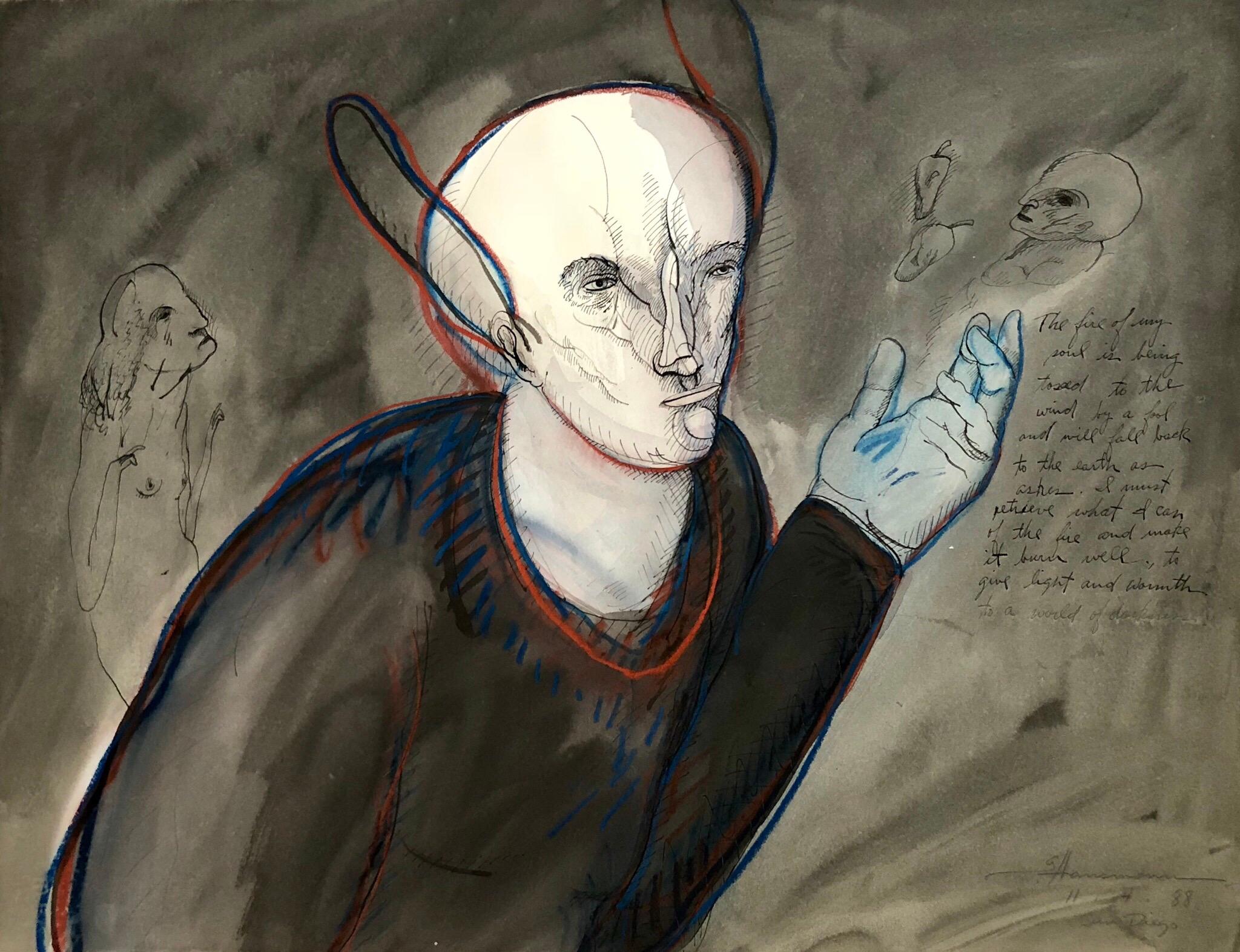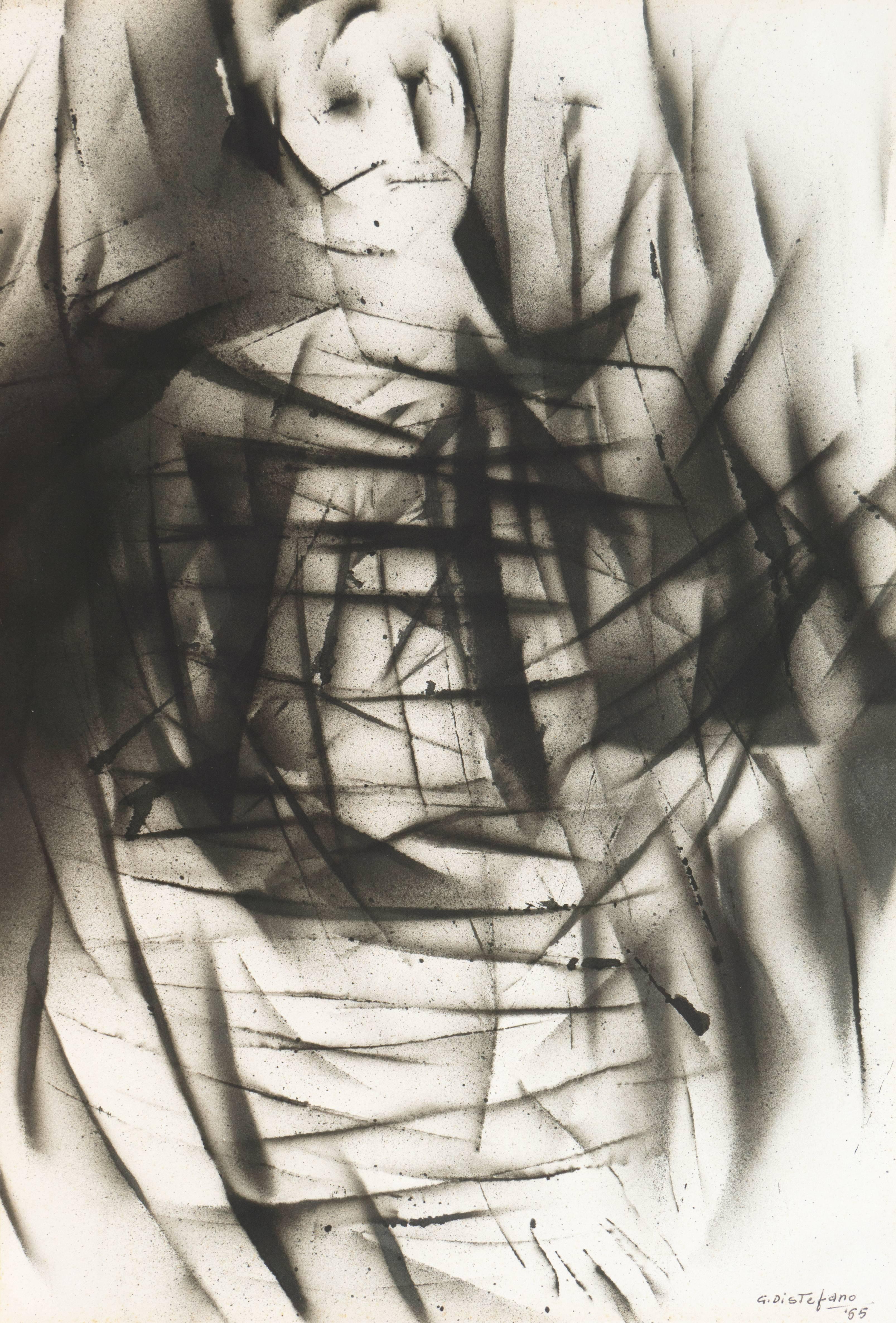Figurative Ink Drawing of Father Holding His Child 1970-80s
View Similar Items
1 of 4
Morris KronfeldFigurative Ink Drawing of Father Holding His Child 1970-80s 1970-80s
1970-80s
About the Item
- Creator:Morris Kronfeld (1914 - 2011, American)
- Creation Year:1970-80s
- Dimensions:Height: 20 in (50.8 cm)Width: 16.5 in (41.91 cm)
- Medium:
- Movement & Style:
- Period:
- Condition:Minor vintage wear.
- Gallery Location:San Francisco, CA
- Reference Number:Seller: 721291stDibs: LU29825121581
You May Also Like
- Glassblowers WPA American Scene Mid- 20th Century Modern Figurative Workers 1932By Harry GottliebLocated in New York, NYGlassblowers WPA American Scene Mid- 20th Century Modern Figurative Workers. Dated and signed "32 Harry Gottlieb" lower right. Sight: 13 1/8" H x 18 1/4" W. Harry Gottlieb, painter, screenprinter, educator, and lithographer, was born in Bucharest, Rumania. He emigrated to America in 1907, and his family settled in Minneapolis. From 1915 to 1917, Gottlieb attended the Minneapolis Institute of Arts. After a short stint as an illustrator for the U.S. Navy, Gottlieb moved to New York City; he became a scenic and costume designer for Eugene O"Neill's Provincetown Theater Group. He also studied at the Philadelphia Academy of Fine Arts and the National Academy of Design. He was one of America's first Social Realist painters, influenced by that Robert Henri-led movement in New York City where Gottlieb settled in 1918. He was also a pioneer in screen printing, which he learned while working for the WPA. He married Eugenie Gershoy, and the couple joined the artist colony at Woodstock, New York. He lectured widely on art education. In 1923, Gottlieb settled in Woodstock, New York and in 1931, spent a a year abroad studying under a Guggenheim Fellowship. In 1935, he joined the Federal Art Project...Category
1930s American Modern Figurative Paintings
MaterialsPaper, Gouache
- Mid Century "Driver with Hard Hat" Gouache and Oil Pastel Figurative 1960s SFBy Gloria DudfieldLocated in Arp, TXGloria Dudfield Driver with Hard Hat 1960s Gouache and Oil Pastel on Paper 27"x36" unframed $700 *Custom framing available for additional charge. Please expec...Category
Mid-20th Century American Modern Figurative Drawings and Watercolors
MaterialsOil Pastel, Paper, Gouache
- Large Watercolor Painting John Groth, Men Wrestling, Esquire Magazine WPA ArtistBy John GrothLocated in Surfside, FLJohn August Groth (American, 1908-1988) "Wrestling Match," Watercolor painting, hand signed upper right and inscribed upper left, "Las Palmas Canary Islands Lucha Canary Wrestling". Framed Size: 21'' x 29'', 53 x 74 cm (sight); 28.5'' x 36.25'', 72 x 92 cm (frame). Depiction of a wrestling match in a city square. John August Groth (1908 - 1988) was an illustrator and art teacher. He gained recognition as a war correspondent-illustrator. He studies at the Art Institute of Chicago and at Art Students League with Todros Geller, Robert Brackman, Arnold Blanch and George Grosz. He was a member: Society of American Etchers; American Newspaper Guild; Society of Illustrators; Associate Member of the National Academy of Design; American Water Color Society. Positions : Art Director at Esquire 1933 - 1937, Parade Publications 1941 - 1944; War Correspondent for Chicago Sun 1944; American Legion Magazine 1945; Artist-Correspondent in Vietnam 1967.Teacher at Art Students LeagueHe was the first art director of Esquire Magazine and taught at the Art Students League, the Pratt Institute, and the Parsons School of Design. In 1940, he was included in an exhibition at MOMA, titled, "PM Competition: The Artist as Reporter." The exhibition included Philip Guston, Reginald Marsh, John Tworkov, John Heliker, Adolf Dehn, and Chet La More. Groth began sketching intently during the Great Depression after studying at the Art Institute of Chicago. Following the advice of an editor, he penned 100 sketches a day for years. He learned to increase his speed by listening to sports on the radio and sketching the action as fast as he could. "I would listen to the games on the radio at night, and sketch the plays. It made me very quick." His break came when Arnold Gingrich, an editor for Esquire magazine, approached him at an art show in Chicago and offered him a position. "The way (Arnold Gingrich) told it," John Groth says, "he found this barefoot, bearded kid in the park, and the next day made him art director of the world's leading men's fashion magazine. But I swear I was wearing shoes." Groth went on to work as a correspondent and illustrator for the Chicago Sun, Collier's, Sports Illustrated, and The Saturday Evening Post. He developed a passion for war zones. He covered six different wars and was one of the first correspondents in Paris after its liberation. "It is only at war that I feel complete... There, you meet all sort of men -- farmers, mechanics, college professors. It rains on them and it rains on you. The shells burst in the air, and you are there, too." He would make a splash when he beat out friend and rival, Ernest Hemingway, into Paris in 1944. Hemingway was writing for the Chicago Tribune and Groth for the Chicago Sun. Groth was in the first jeep into Paris and got the scoop. His headline read, "Yanks are in Paris!" Hemingway would later write about Groth's technique. “None of us understood the sort of shorthand he sketched in. The men would look at the sketches and see just a lot of lines. It was a great pleasure to find what fine drawings they were when we got to see them. Groth went on to illustrate such classic books as: A Christmas Carol, All Quiet on the Western Front, The Grapes of Wrath, The War Prayer, and Gone with the Wind. Deborah Churchman described Groth's work in a 1980 Washington Post article: "Groth's pictures center on the day-to-day life of people caught in terrifying circumstances -- armies occupying cities, soldiers sweeping roads for land mines, bullfighters facing death." Bernie Schonfeld, a photographer for Life Magazine said of Groth, "John is one of the gentlest people in the world, and he always gets himself into the wildest hell hole." He joined the First Congress of American Artists Against War and Fascism in 1936, along with Stuart Davis, Peter Blume...Category
Mid-20th Century American Modern Figurative Paintings
MaterialsPaper, Watercolor
- "In Foreign Parts" Eugene Higgins, Southwestern Pueblo, Modern FigurativeBy Eugene HigginsLocated in New York, NYEugene Higgins In Foreign Parts, circa 1913 Signed lower right Watercolor on paper Sight 17 x 13 inches Born William Victor Higgins in 1884 to a Shelbyville, Indiana farm family where the only art Victor was aware of as a child was his father's love of flowers. "He loved their forms and their colors, and he tended his garden as a painter might work a canvas." At the age of nine, Victor met a young artist who traveled the Indiana countryside painting advertisements on the sides of barns. He purchased paints and brushes so the young Higgins could practice his own artwork on the inside of his father's barn. He also taught Victor about art museums and especially about the new Chicago Art Institute. This information never left the young artist, and he saved his allowance until his father allowed him at the age of fifteen to attend Chicago Art Institute. He worked a variety of jobs to finance his studies both there and at the Academy of Fine Arts. Victor Higgins traveled to New York in 1908, where he met Robert Henri, who became a significant influence by depicting every-day scenes and stressing the importance of the spirit and sense of place as important factors in painting. Higgins was also greatly affected by the New York Armory Modernism Show of Marsden Hartley in 1913. While Victor Higgins was in Chicago he met former mayor and avid collector Carter H. Harrison who was to prove instrumental in the growth of Higgins career for several years. Harrison agreed to support Higgins for four years to go to Paris and Munich and paint and study in the great museums in Europe. While at the Academie de la Grande Chaumier in Paris (1910-1914) he met Walter Ufer, who was another Chicago artist being sponsored by Carter Harrison. This meeting was not only a life-long friendship, but the beginning of a great change in the way Higgins looked at "American" art. He decided that America needed it's own authentic style rather than the 19th Century classic style he was taught in Europe. Very soon after returning to Chicago in 1914, Harrison sent him and Walter Ufer on a painting trip to Taos, New Mexico for a year in exchange for paintings. Higgins made other similar agreements and was able to support himself with his painting. This trip was a life-changing experience and introduced Higgins to the authentic America he had been looking for. In 1914 Taos was an isolated village about twelve hours from Santa Fe on an impossible dirt road. But the colorful life of the pueblo people and the natural beauty drew a collection of artists who became the Taos art colony, from which the Taos Society of Artists was founded in 1915. Victor Higgins became a permanent resident within a year of his arrival and a member of the society in 1917, exhibiting with Jane Peterson in 1925 and with Wayman Adams and Janet Scudder in 1927. The members would travel around the country introducing the Southwest scenes with great success. He remained a member until the Society's dissolution in 1927. Higgins was the youngest member of the group of seven. Other members were Joseph Henry Sharp, Bert Phillips...Category
1910s American Modern Figurative Drawings and Watercolors
MaterialsWatercolor, Paper
- 1950s "At the Table" Mid Century Figurative Gouache & Oil PastelBy Donald StacyLocated in Arp, TXDonald Stacy "At the Table" c.1950s Gouache and oil pastel on paper 24"x18" unframed Came from artist's estate *Custom framing available for additional charge. Please expect framing ...Category
Mid-20th Century American Modern Figurative Paintings
MaterialsOil Pastel, Paper, Gouache
- Modern Figurative Surrealism Watercolor Painting, Drawing California ArtistBy Gary HansmannLocated in Surfside, FL"The Sadness of Mr. lapin After the Artist Left" Gary Hansmann (1947-2008) was active/lived in California. He is known for abstract, Surrealism figure painting. Gary William Hansmann was born Dec. 4, 1940, in San Diego to Ethel May Williams and Lester Hughes Hansmann. He grew up in Encinitas and served in the Army in the early 1960s. Gary Hansmann, San Diego artist, teacher and gallery owner, was known for his Surrealist nude and animal drawings and graphics. He spent time working in Paris and exhibiting his art throughout Europe, but San Diego was home until he moved to Washington state. His life partner was fellow artist, Jill Hosmer. Mr. Hansmann, a respected printmaker and prolific artist, created thousands of drawings, prints and paintings as well as hundreds of poems. His interest in bullfighting led to a book of poetry and illustrations on the subject, “La Corrida, The Run”, a collection of poetry & artwork written as he was preparing for his first bullfight. Prologue written by famous Mexican Matador Antonio Lomelin. The book is written in English and translated into Spanish on opposing pages and was published in 1983. Mr. Hansmann taught intaglio and monotype at the Academy of Fine Arts in San Diego from 1977 to 1980 and at the San Diego Museum of Art in 1980. He also gave lectures and demonstrations throughout the art community, including at the San Diego Art Guild in Del Mar and Artist Equity in San Diego. Although he attended Palomar College in San Marcos and studied lithography at the San Diego Academy of Fine Arts, Mr. Hansmann was mostly self-taught and self-educated. Mr. Hansmann had shows in several art-world capitals, including Paris; Lisbon, Portugal; Cologne, Germany; Brussels, Belgium; and New York. he had one-person exhibits at the Loft Gallery in Clarkston, the Lewis-Clark State College Center of Arts & History, the Carnegie Art Center in Walla Walla and the Valley Art Center in Clarkston. During his long, distinguished career as an artist he had numerous one-person exhibits all over the world and the United States. His group shows are too numerous to mention, but his one-person exhibits were in Koln, Germany; Bruxelles, Belgium; Paris, France; Viana do Castelo, Portugal; Lisbon, Portugal; Tecate, Mexico; and British Columbia, Canada; and many states at home. Palomar College, San Marcos, Calif. San Diego Academy of Fine Arts Brooklyn Museum, Brooklyn, N.Y. University of Southern California, Idyllwild (ISOMATA) University of San Diego San Diego Museum of Art James Copley Library, La Jolla, Calif. Biblioteca Nazionale Marciana, Venice, Italy Centre de Arte Moderna Gulbenkian Foundation, Lisbon, Portugal Museo Taurino de la Communidad de Madrid, Madrid, Spain Atelier Lacouriere et Frelaut, Paris, France Gordon Gilkey Collection Portland Art Museum, Portland, Or. Coos Art Museum, Coos Bay...Category
1980s Surrealist Figurative Paintings
MaterialsPaper, India Ink, Watercolor
Recently Viewed
View AllMore Ways To Browse
Greenwich Vintage
Greenwich Village Nyc
Vintage Glasses Frames India
Vintage Biology Drawings
80s Womens Fashion
Art Deco Figurative Pencil Drawings
Blue Pastel Bag
Chalk On Blue Paper
Dali Ink Drawing
Erotic Male Painting
Vintage Biba Label
Indian Erotic Painting
Womens Ralph Lauren
The North American Indian Book
Nick Knight
Fleur Du Mal
Laura Ashley Clothing Vintage
Lanvin Painting
